 W
WNeptune is the god of freshwater and the sea in Roman religion. He is the counterpart of the Greek god Poseidon. In the Greek-influenced tradition, Neptune is the brother of Jupiter and Pluto; the brothers preside over the realms of Heaven, the earthly world, and the Underworld. Salacia is his wife.
 W
WThe Arrival of Marie de Medici at Marseilles is a c. 1622-1625 Baroque painting done by Sir Peter Paul Rubens. It was commissioned by Marie de' Medici of France to commemorate the life of her and her husband Henry IV of France. This painting was one of the 24 paintings in the Marie de' Medici cycle by Rubens. The painting currently resides in the Louvre in Paris.
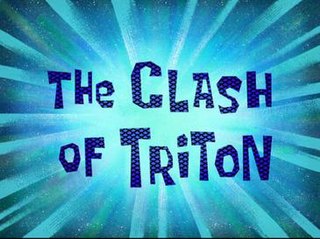 W
W"The Clash of Triton", also known as "Neptune's Party", is the 26th and final episode of the sixth season of the American animated television series SpongeBob SquarePants, and the 126th episode of the series overall. It originally aired on Nickelodeon in the United States on July 5, 2010.
 W
WThe Hudson, New York, Sesquicentennial half dollar, sometimes called the Hudson Sesquicentennial half dollar, is a commemorative fifty-cent piece struck by the United States Bureau of the Mint in 1935. The coin was designed by Chester Beach. Its obverse depicts the Half Moon, flagship of Henry Hudson, after whom the city of Hudson, New York is named. In addition to showing the ship, the coin displays a version of the Hudson city seal, with Neptune riding a whale, a design that has drawn commentary over the years.
 W
WThe lectisternium was an ancient Roman propitiatory ceremony, consisting of a meal offered to gods and goddesses. The word derives from lectum sternere, "to spread a couch." The deities were represented by their busts or statues, or by portable figures of wood, with heads of bronze, wax or marble, and covered with drapery. It has also been suggested that the divine images were bundles of sacred herbs tied together in the form of a head, covered by a waxen mask so as to resemble a kind of bust, rather like the straw figures called Argei. These figures were laid upon a couch (lectus), the left arm resting on a cushion in the attitude of reclining. The couch was set out in the open street, and a meal placed before it on a table.
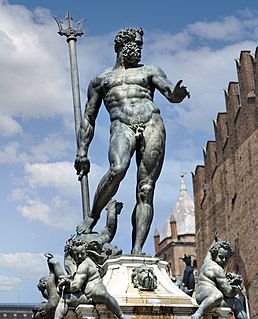 W
WThe Neptunalia was an obscure archaic two-day festival in honor of Neptune as god of waters, celebrated at Rome in the heat and drought of summer, probably 23 July. It was one of the dies comitiales, when committees of citizens could vote on civil or criminal matters. In the ancient calendar this day is marked as Nept. ludi et feriae, or Nept. ludi, from which Leonhard Schmitz concluded that the festival was celebrated with games (ludi). Respecting the ceremonies of this festival nothing is known, except that the people used to build huts of branches and foliage, in which they probably feasted, drank, and amused themselves.
 W
WNodens is a Celtic deity associated with healing, the sea, hunting and dogs. He was worshipped in ancient Britain, most notably in a temple complex at Lydney Park in Gloucestershire, and possibly also in Gaul. He is equated with the Roman gods Mars, Neptune and Silvanus, and his name is cognate with that of the Irish mythological figure Nuada and the Welsh Nudd.
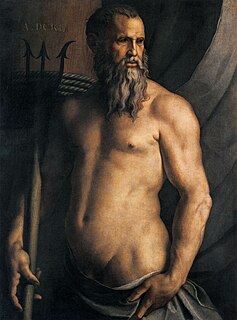 W
WThe Portrait of Andrea Doria as Neptune is an oil painting on canvas completed by Bronzino for a private collection in either the 1530s or 1540s. It is now in the Pinacoteca di Brera in Milan, Italy. An oil painting on canvas, it measures 199.5 centimetres (78.5 in) by 149 centimetres (59 in). In a conscious revival of the convention in classical sculpture of showing important political figures in heroic nudity, it depicts the Genoan admiral, Andrea Doria, posing as the classical god of the sea, Neptune.
 W
WIn ancient Roman mythology, Salacia was the female divinity of the sea, worshipped as the goddess of salt water who presided over the depths of the ocean. Neptune was her consort. That Salacia was the consort of Neptune is implied by Varro, and is positively affirmed by Seneca, Augustine and Servius. She is identified with the Greek goddess Amphitrite, consort of Poseidon.
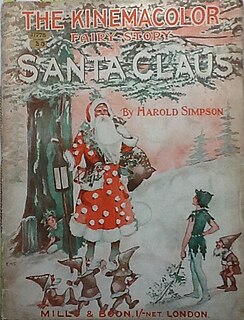 W
WSanta Claus is a 1912 fantasy silent film in which a little girl dreams that she goes to Toyland where she helps Santa Claus in his workshop.
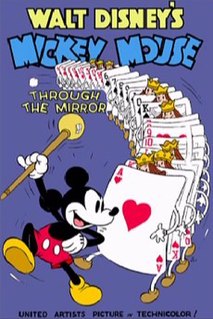 W
WThru the Mirror is a Mickey Mouse cartoon short film produced by Walt Disney Productions and released by United Artists in 1936. In this cartoon short, Mickey has a Through the Looking-Glass-type dream that he travels through his mirror and enters a topsy-turvy world where everything is alive. While there, he engages in a Fred Astaire dance number with a pair of gloves and a pack of cards, until the cards chase him out of the bizarre world. It was the 83rd Mickey Mouse short film to be released, the fourth of that year.